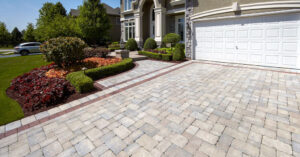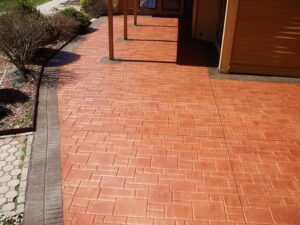When it comes to transforming the exterior of your home, curb appeal matters more than ever. Whether you’re preparing to sell your property or simply want to enhance its appearance, your choice of hardscaping material plays a crucial role. Among the most popular options are stamped concrete and pavers—each offering unique benefits, design versatility, and value. But which one delivers more curb appeal?
At Amazon Construction Corp., we specialize in both stamped concrete and paver installations across New Jersey. With over 30 years of experience in paving and masonry services, our team has helped countless homeowners boost property value through beautifully designed driveways, patios, walkways, and more. In this post, we’ll explore every angle of the stamped concrete vs. pavers debate so you can confidently choose the best fit for your home.
What Is Stamped Concrete?
Stamped concrete is a decorative style of concrete that’s poured and then pressed with patterns and textures to mimic the look of stone, tile, wood, brick, or other materials. It’s incredibly popular for driveways, patios, pool decks, and walkways.
One of the biggest advantages of stamped concrete is its ability to deliver a high-end, custom appearance without the cost of natural stone or individual pavers. Concrete is poured as a single slab, making it seamless and uniform, which helps reduce weed growth and movement between pieces.
Beyond appearance, stamped concrete offers excellent flexibility in terms of design. With a wide variety of colors, patterns, and finishes to choose from, homeowners can create surfaces that perfectly match their architecture and landscaping. From slate and flagstone to cobblestone and brick finishes, stamped concrete can mimic nearly any material while maintaining the strength of poured concrete.
What Are Pavers?
Pavers are individual units made of concrete, stone, or brick that are laid in interlocking or customized patterns. Unlike stamped concrete, which is poured as a single slab, pavers are laid piece by piece over a prepared base of sand or gravel.
The major appeal of pavers lies in their durability, repairability, and classic look. Since they are not poured like concrete, they resist cracking and can be easily replaced if damage occurs. This makes them a smart choice for driveways, walkways, patios, and even pool surrounds.
Pavers come in countless shapes, sizes, textures, and colors, allowing for intricate, elegant patterns and border work. Whether you want a European cobblestone street aesthetic or a sleek modern layout, pavers provide unmatched design flexibility.
Aesthetic Appeal: Which Looks Better?
When comparing stamped concrete vs. pavers for visual appeal, both materials bring beauty to a property in different ways. The choice ultimately depends on your personal taste, budget, and the architectural style of your home.
Stamped concrete offers a sleek, continuous finish that works especially well with modern or contemporary homes. It gives the appearance of stone or tile without grout lines or separations. The application of stains and sealers enhances the texture and makes colors pop, adding a polished feel to any space.
In contrast, pavers give a textured, dimensional look that often feels more traditional or rustic. Their individual shapes create striking patterns like herringbone, basketweave, or running bond. For homes with brick facades or more classic exteriors, pavers tend to complement the design more naturally.
Winner for curb appeal? It’s a tie—stamped concrete offers modern elegance, while pavers deliver timeless charm. Choosing between the two should be based on the visual theme you’re going for.
Durability and Longevity
Durability is a critical factor in choosing between stamped concrete and pavers. Both are long-lasting, but they differ in how they stand up to wear, weather, and time.
Stamped concrete is highly durable when properly installed and maintained. However, because it’s a solid slab, it is more prone to cracking, especially in regions with freeze-thaw cycles. If cracking occurs, it can be difficult to repair without affecting the overall look.
Pavers are more flexible and less likely to crack, as their individual pieces allow for ground movement. In areas with harsh winters or frequent temperature fluctuations, pavers typically perform better over time. Plus, if one or two pavers become damaged, they can be replaced without disturbing the rest of the surface, making maintenance easier and cheaper in the long run.
In terms of long-term reliability, pavers have the edge. Their resistance to cracking and ease of repair gives them a clear advantage in durability.
Installation Time and Process
The installation process for stamped concrete vs. pavers differs significantly in time, labor, and complexity.
Stamped concrete involves pouring concrete, smoothing it, adding color (either as an integral dye or surface stain), and then applying stamp mats to create the desired pattern. The concrete must then be cured and sealed. This entire process takes several days, as it involves drying and curing times.
Pavers require more initial groundwork, including excavation, grading, and the laying of a gravel base. Each unit is then placed manually and compacted into place. The process can be more labor-intensive but does not involve curing time, which means the area can usually be used immediately after installation.
If you’re looking for quicker usability, pavers may be the better option. However, if you prefer a seamless finish and don’t mind the wait, stamped concrete is a solid choice.
Maintenance Requirements
Both materials require maintenance, but the level and type vary greatly.
Stamped concrete must be sealed every 2 to 3 years to preserve its color, texture, and resistance to stains or damage. Over time, the sealer may wear down and need reapplication. In areas with snow or heavy traffic, the surface can fade, stain, or deteriorate without proper care.
Pavers are lower-maintenance overall. They may need occasional resealing for color preservation, and joints should be refilled with sand every few years to prevent shifting or weed growth. Power washing and occasional spot cleaning can keep them looking fresh.
From a homeowner’s perspective, pavers win for low-maintenance care and longevity without constant attention.
Cost Comparison: Which Offers Better Value?
Budget plays a big role in home improvement projects. So how do the costs of stamped concrete vs. pavers compare?
Stamped concrete is generally less expensive upfront. Material and labor costs are lower due to faster installation and fewer materials. On average, stamped concrete costs $10 to $18 per square foot, depending on complexity and finishes.
Pavers cost more upfront, typically ranging from $14 to $24 per square foot. However, they may prove to be more cost-effective over time due to lower maintenance costs and longer lifespan. The ability to replace individual units without redoing the entire surface also helps control future repair expenses.
For long-term investment, pavers may offer a better return—especially if you plan to live in your home for many years or want maximum resale value.
Weather and Climate Considerations
Your local climate can affect how both materials perform and age.
In New Jersey’s climate, with its seasonal snow, rain, and temperature shifts, pavers tend to hold up better due to their flexibility and water drainage capabilities. The freeze-thaw cycle can cause concrete slabs to crack if not properly installed or sealed.
Stamped concrete can still perform well in these conditions if it’s professionally installed with expansion joints and sealed regularly. However, it may require more frequent attention in cold or wet environments.
Pavers are typically a safer bet for long-term performance in variable weather conditions.
Eco-Friendliness and Water Drainage
For environmentally conscious homeowners, both options have green benefits—but one pulls ahead in terms of sustainability. In fact, the EPA encourages the use of permeable pavement as a smart solution for soaking up rainfall and mitigating water pollution.
Pavers offer better water drainage since they are installed over a porous base and include gaps between each piece. This design allows rainwater to seep into the ground, reducing runoff and helping with stormwater management. Many modern pavers are also made from recycled or sustainable materials, making them a more eco-conscious choice.
Stamped concrete is less permeable, though certain finishes and sealers can help reduce runoff. Permeable concrete options exist, but they’re not as commonly used for stamped applications.
If sustainability is a priority, pavers are more environmentally friendly and practical for managing outdoor water flow.
Resale Value and Marketability
Curb appeal doesn’t just make your home prettier—it increases property value. When prospective buyers pull into the driveway or stroll through the yard, a beautiful, well-maintained hardscape creates an immediate positive impression.
Pavers often deliver higher resale value due to their upscale appearance, durability, and ease of repair. Buyers know that a paver driveway or patio is built to last and can be updated piece by piece.
Stamped concrete still offers excellent value, especially when maintained well, but some buyers may be cautious due to potential cracking or maintenance costs.
For long-term ROI and marketability, pavers are typically viewed more favorably by real estate professionals.
Final Verdict: Stamped Concrete vs. Pavers
So which option wins the battle for curb appeal—stamped concrete or pavers?
Here’s a quick breakdown:
-
Design Aesthetics: Tie – stamped concrete for modern, pavers for classic
-
Durability: Pavers win
-
Installation Time: Stamped concrete is faster
-
Maintenance: Pavers are lower maintenance
-
Cost Efficiency: Stamped concrete upfront, pavers long-term
-
Weather Resistance: Pavers perform better in NJ
-
Eco-Friendliness: Pavers are greener
-
Resale Value: Pavers increase property appeal more
In summary, pavers offer slightly better curb appeal and performance across several factors, especially in a region like New Jersey. But stamped concrete remains a beautiful, cost-effective option for homeowners looking for an artistic finish with less upfront expense.
Transform Your Home with Amazon Construction Corp.
At Amazon Construction Corp., we help homeowners throughout New Jersey bring their exterior spaces to life with expert hardscaping solutions. Whether you’re leaning toward the smooth finish of stamped concrete or the classic elegance of pavers, our experienced team will guide you through every step—from planning and design to final installation.
Let us help you create the curb appeal your home deserves. With over 30 years of experience, a reputation for quality, and 100% satisfaction guaranteed, we’re your go-to partner for outdoor transformation.
Contact Amazon Construction Corp.
Ready to get started? Contact us today for a free estimate and expert consultation on your next paving or masonry project.
📞 Phone: 848.342.4357
📧 Email: amazonconstructioncorp@gmail.com
🌐 Website: www.amazonpavingandmasonry.com
📍 Location: Serving all of New Jersey





0 Comments